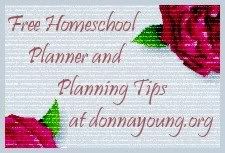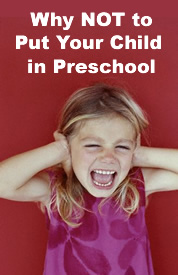What Your Preschooler Needs, Age-by-Age
Posted by homeschoolmentormom on October 13, 2012
Two year olds: This year marks a transition from toddlerhood to childhood. Imaginative play will blossom for your child this year; his thinking and speaking skills will grow in amazing ways as well. Be sure to choose toys that encourage this: Play phones, dolls, play kitchens, blocks, cars, and so on. Duplo- sized Legos are also great for imaginative play, as well as building hand strength and dexterity. Favorite toys at this age: Fisher-Price Little People sets, (these will be favorite for a couple of years), stack and nest cups or blocks, knob puzzles, and beads to string.
Two-year-olds need plenty of time to play outside as well—sand play, tricycles, and swing sets are popular, along with play props like balls, hoops, etc. Occasionally, bring inside toys outside to renew your child’s interest in them. (NOTE: Supervise your two-year old when s/he is outside at all times! Some two year olds still like to eat or throw sand–and two year olds are notorious for climbing where they shouldn’t.
Your child’s daily routine should be expanded again to include music (listening, rhythm band and singing), finger plays, and art experiences: painting with watercolors or tempera paint, and simple craft projects using paste or glue. A collage is a great way to start.
Many two year olds don’t seem to stop moving from morning till night. They need our help to calm themselves. Music and reading aloud do this beautifully. Be sure to plan some read aloud times—at least once mid-morning, after lunch/before nap, and again before bed. Throughout the day, alternate boisterous activities with quiet ones like reading or play dough. This helps keep your child from getting overtired, and keeps emotions on an even keel.
Three and four year olds: Your child is officially a “preschooler”! But that doesn’t mean he’s ready to be drilled on his colors, numbers, or alphabet. Instead, help him learn those “preschool facts” through play and reading aloud. Continue to talk, talk, talk to your preschooler, naming everything you see, and explaining everything you do. This grows his vocabulary and his understanding.
Children this age are ready for short “preschool” schedules of their own. ” Preschool” at homel doesn’t need to take longer than an hour or two, and can be interspersed between your older children’s school work. Include Bible stories/devotions, calendar, music, finger-plays, and story time daily; try to provide an art experience at least three days a week. You can also explore cooking and baking activities and simple science experiments once in a while.
Begin memory work with your child if you haven’t already. Simply repeating scriptures to your child over and over or listening to scripture memory songs will produce quick memorization in most children this age. We often practiced our memory verses in the bathtub, where I had a captive audience.
Introduce your child to (safety) scissors and pencils, pens, and felt-tipped pens if you haven’t already, and begin to leave age appropriate art materials out for him to use whenever he wants to. The added blessing of these activities is that they can keep your child entertained for long periods of time while you school your older children.
Games are great ways for preschoolers to learn. Use store-bought games like Concentration, Hi-Ho Cheerio, Bingo, Dominoes, Chutes and Ladders, and Candyland to teach your child those “preschool facts” painlessly (counting, turn-taking, matching, and more.) It’s easy to make your own card games, bingo games, matching games, and felt board games, as well. Remember to be patient and wait for interest and readiness when it comes to early learning. Studies have shown no long-term benefit to early formal academics, and lots of possible harm. (Remember, Homepreschool and Beyond has an entire chapter full of tips and ideas for learning games.)
Play for preschoolers: Three year olds and four year olds have more patience than two year olds do, and enjoy playing with more complicated building toys. They love blocks such as CitiBlocks, Dr. Drew’s Blocks, or the classic “Unit Blocks” (read about the benefits of block play/what children learn HERE.) A good set of blocks might be expensive, but they will be used for many years. Even older children and adults enjoy Citblocks or Dr. Drew’s Blocks. My boys (9 and 11) still play with ours now and then–just look at the complicated designs possible on the websites above and you’ll see why. IDEA: Combine blocks and cars or blocks and plastic animals and you’ve got twice the fun—kids will build towns, garages, zoos, and more
Preschoolers also enjoy more complicated puzzles, games, and imaginary play. If you haven’t introduced prop boxes yet, now is a great time to do so! Prop boxes are easy to put together from household items, and really do encourage imaginary play.
Finally: Remember to “keep the main thing the main thing.” The main thing preschoolers need to be taught is to know about and love the Lord, to love their family, and to obey their parents. They also need other “moral” lessons, which should all be framed within a Biblical perspective–lessons about telling the truth, being kind, being forgiving using self-control, etc etc. These lessons are far more important than any lessons intended to teach those “preschool facts” that everyone seems to worry about (colors, shapes, numbers, alphabet.)
Other posts you might enjoy: What Preschoolers Should Be Learning: The Best Curriculum for Preschoolers
The Four R’s for Early Learners (Preschoolers)
The Goals of Spiritual Development
© 2012 Susan Lemons all rights reserved. Copyrighted materials may not be re-distributed or re-posted without express permission from the author.






Leave a comment